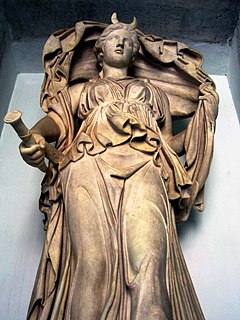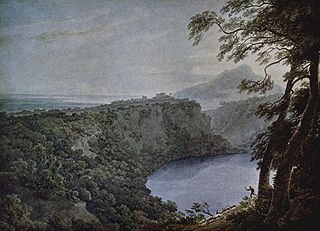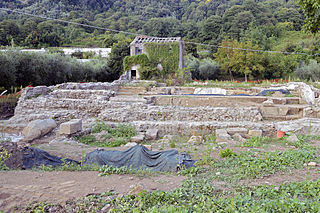Related Research Articles

Diana is a goddess in Roman and Hellenistic religion, primarily considered a patroness of the countryside, hunters, crossroads, and the Moon. She is equated with the Greek goddess Artemis, and absorbed much of Artemis' mythology early in Roman history, including a birth on the island of Delos to parents Jupiter and Latona, and a twin brother, Apollo, though she had an independent origin in Italy.

In ancient Roman religion and myth, Luna is the divine embodiment of the Moon. She is often presented as the female complement of the Sun, Sol, conceived of as a god. Luna is also sometimes represented as an aspect of the Roman triple goddess, along with Proserpina and Hecate. Luna is not always a distinct goddess, but sometimes rather an epithet that specializes a goddess, since both Diana and Juno are identified as moon goddesses.

Lake Nemi is a small circular volcanic lake in the Lazio region of Italy 30 km (19 mi) south of Rome, taking its name from Nemi, the largest town in the area, that overlooks it from a height.

Egeria was a nymph attributed a legendary role in the early history of Rome as a divine consort and counselor of Numa Pompilius, the second king of Rome, to whom she imparted laws and rituals pertaining to ancient Roman religion. Her name is used as an eponym for a female advisor or counselor.
Tiberius Claudius Balbillus Modestus, more commonly known as Tiberius Claudius Balbilus, was a distinguished Ancient Roman scholar, politician and a court astrologer to the Roman emperors Claudius, Nero and Vespasian.

The rex Nemorensis was a priest of the goddess Diana at Aricia in Italy, by the shores of Lake Nemi, where she was known as Diana Nemorensis. The priesthood played a major role in the mythography of James George Frazer in The Golden Bough; his interpretation has exerted a lasting influence.

Nemi is a town and comune in the Metropolitan City of Rome, in the Alban Hills overlooking Lake Nemi, a volcanic crater lake. It is 6 kilometres (4 mi) northwest of Velletri and about 30 kilometres (19 mi) southeast of Rome.

Ariccia is a town and comune in the Metropolitan City of Rome, central Italy, 16 miles (25 km) south-east of Rome. It is in the Alban Hills of the Lazio (Latium) region and could be considered an extension of Rome's southeastern suburbs. One of the Castelli Romani towns, Ariccia is located in the regional park known as the "Parco Regionale dei Castelli Romani".
A triple deity is three deities that are worshipped as one. Such deities are common throughout world mythology; the number three has a long history of mythical associations. Carl Jung considered the arrangement of deities into triplets an archetype in the history of religion.

Diana Nemorensis, also known as "Diana of the Wood", was an Italic form of the goddess who became Hellenised during the fourth century BC and conflated with Artemis. Her sanctuary was to be found on the northern shore of Lake Nemi beneath the cliffs of the modern city Nemi. This lake is referred to by poets as speculum Dianae – "Diana's Mirror"; by the town of Aricia which was situated about three miles off, at the foot of the Albanus Mons, the Alban Mount, and separated by a steep descent from the lake, which lies in a small crater-like hollow on the mountainside.

The Nemoralia is a three-day festival originally celebrated by the ancient Romans on the Ides of August in honor of the goddess Diana. Although the Nemoralia was originally celebrated at the Sanctuary of Diana at Lake Nemi, it soon became more widely celebrated. The Catholic Church may have adapted the Nemoralia as the Feast of the Assumption.
Lucius Volusius Saturninus was a Roman senator who held several offices in the emperor's service. Saturninus attracted the attention of his contemporaries for his long life: he died at the age of 93, and having sired a son at the age of 62.
Quintus Volusius Saturninus was a Roman Senator who lived in the Roman Empire during the Principate. He was consul in the year 56 with Publius Cornelius Scipio as his colleague.
Lucius Volusius Saturninus, also known as Lucius Volusius was a Roman Senator from a plebeian family. He was a cousin of emperor Tiberius.
Quintus Volusius Saturninus was a Roman Senator who lived in the Roman Empire in the second half of the 1st century and the first half of the 2nd century. He was ordinary consul for the year 92 as the colleague of the Emperor Domitian, consul for the sixteenth time. He is primarily known through inscriptions.
Titus Sextius Magius Lateranus was a Roman Senator who lived during the second half of the 1st century and first half of the 2nd century. Lateranus served as a consul ordinarius in 94 as the colleague of Lucius Nonius Calpurnius Torquatus Asprenas. He is known entirely from inscriptions.
Licinia Cornelia Volusia Torquata also known as Cornelia Volusia Torquata Licinia was a noble Roman woman who lived in the Roman Empire in the second half of the 1st century and first half of the 2nd century.
Lollia Saturnina (c.10-41) was a Roman noble woman who lived in the Roman Empire in the 1st century. She was the sister of the Roman empress Lollia Paulina and was a mistress of the Roman emperor Caligula.

The Temple of Diana Nemorensis was an ancient Roman sanctuary erected around 300 BC and dedicated to the goddess Diana. The temple was situated on the northern shore of Lake Nemi beneath the cliffs of the modern city Nemi. It was a famous place of pilgrimage in the Italian peninsula. The temple complex covered an area of 45000 square meters.
Vipsania was an ancient Roman noblewoman of the first century BC. She was married to the politician Publius Quinctilius Varus and was a daughter of Roman general Marcus Vipsanius Agrippa and his second wife Claudia Marcella Major.
References
- 1 2 3 4 5 Marzano, Roman Villas in Central Italy: A Social and Economic History, p. 196
- ↑ Biographischer Index der Antike, p. 249
- ↑ Rudolf Hanslik, "Volusia Q.f. Cornelia 23", Realencyclopädie der classischen Altertumswissenschaft , Supplement 9A, col. 1863
- ↑ Levick, Tiberius the Politician, p. 53
- ↑ Green, Roman Religion and the Cult of Diana at Aricia, p. 280
- ↑ Green, Roman Religion and the Cult of Diana at Aricia, p. 63
- ↑ Marzano, Roman Villas in Central Italy: A Social and Economic History, pp. 196-7
- 1 2 3 The World of Class - Images of Class: Patrons - Volusia Cornelia Archived 2013-11-03 at the Wayback Machine
- ↑ Green, Roman Religion and the Cult of Diana at Aricia, p. 263
- ↑ Joshel, Slavery in the Roman World, p. 143